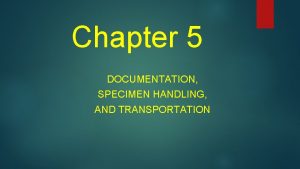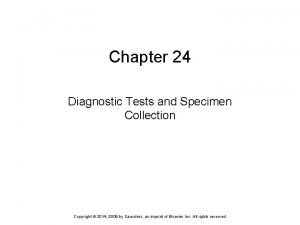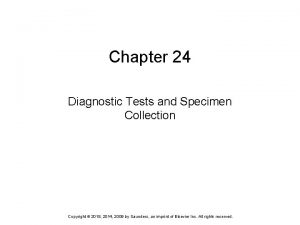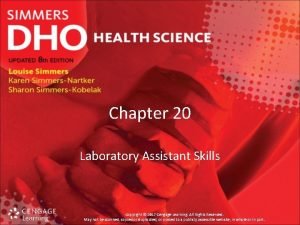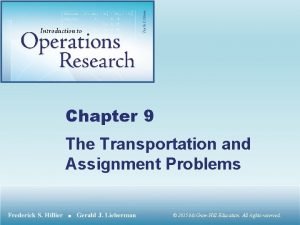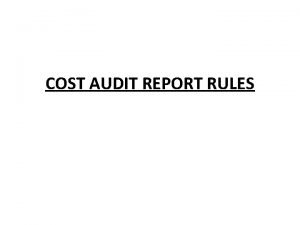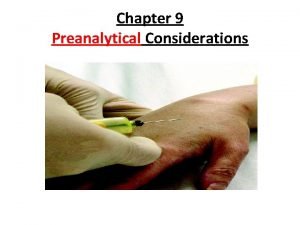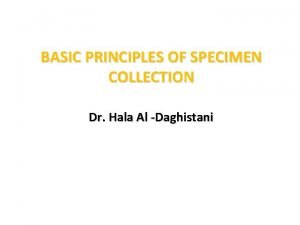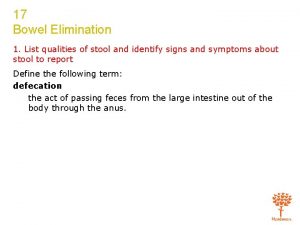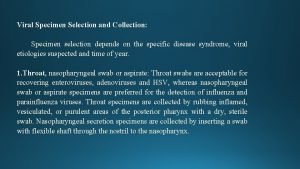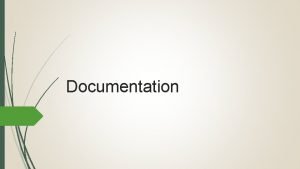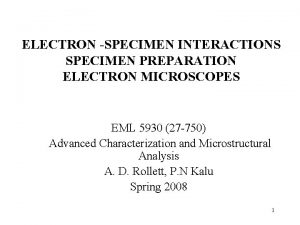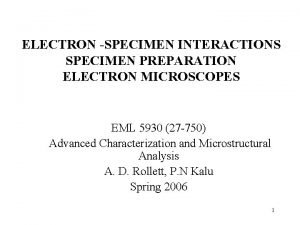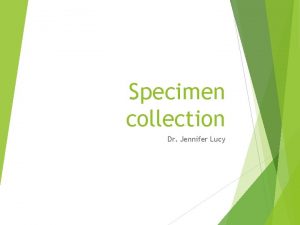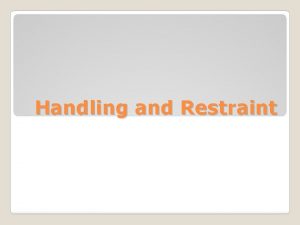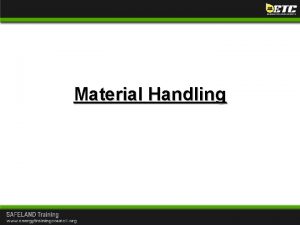Chapter 5 DOCUMENTATION SPECIMEN HANDLING AND TRANSPORTATION Documentation















- Slides: 15

Chapter 5 DOCUMENTATION, SPECIMEN HANDLING, AND TRANSPORTATION

Documentation Basics • Clinical/Medical Record or Electronic Medical Record – Monitoring the quality of care – Coordination of care – Accrediting, licensing, research – Legal protection Medical Record Documentation • The Five C’s: – Concise– Complete– Clear– Correct– Chronologic

Reporting Errors • Report immediately • Include all relevant information • Document errors & corrective actions according to facility’s policy • Be accurate and legible • Correct errors, but do not falsify or delete records Documentation Basics • Policies and Procedures – All health care facilities have manuals that detail operating procedures to be followed. – Health care workers may be involved in developing, writing, and practicing these procedures. – Examples: Safety, Infection Control, QC& Preventive Maintenance, etc.

Laboratory Test Requisitions and Labels • Transmittal of the Test Request to the Laboratory – On-line interactive computer system – Manual request system • Laboratory Test Requisition Forms – Multiple-part requisition may serve as a temporary request until the formal request can be entered into a computer system. – In a manual system, the multipart request forms are more subject to human error. • Patient identification (name, unique registration or identification number, location) • Patient’s gender, date of birth or age • Name of physician or legally authorized person ordering the test • Tests requested • Time and date of specimen collection • Source of specimen • Other pertinent clinical information when appropriate • A “STAT” Request– In cases of emergency– Document the request appropriately

Specimen Labels and Blood Collection Lists • Accurate specimen identification must continue from collection through disposal. • Identification methods vary from manually copying information onto the container to using pre numbered, bar-coded labels. • Labeling systems can imprint a patient identification card or electronically print on to the specimen label. • Computer-Generated Labels Include: – Patient identification– Tests requested– Specimen collection tubes– Transfer labels for aliquots– Accession numbers or sample numbers– Blood drawing list • Bar Codes– Series of light and dark bands that relate to alphanumeric symbols (i. e. , numbers and letters) – When bands are placed together in a series, they can correspond to a name (patient or test) or a number(identification or test code)– Very accurate and fast • Radio Frequency Identification (RFID)– Silicon chip provides ID Tag– Data is transmitted to wireless receiver– Does not require “line-of-sight”– Can track many items simultaneously • Biometrics– Fingerprints– Face recognition– Voice prints– Iris patterns– Retinal vascular patterns– Digitized verification

Specimen Handling and Transport • Specimen Integrity Affected by: – Method of transport – Timing delays – Temperature – Movement/agitation – Exposure to light – Centrifugation methods Centrifugation – Not all specimens need to be centrifuged– Standards for handling and processing of blood samples during pre-centrifugation, and post-centrifugation

Specimen Handling and Transport • Specimen Transportation Guidelines – Leak-proof plastic bag for enclosing and transporting the specimen container. – Transport bag may have a pouch on the outside for the laboratory request slip, thus eliminating potential contamination. – If possible, maintain the blood specimens in evacuated tubes and micro collection tubes in a vertical position to promote complete clot formation and reduce the possibility of hemolysis. – Handle blood specimens gently to reduce chances of hemolysis. – Transport specimens as soon as possible to the clinical laboratory. – Serum can remain at room temperature for testing, be refrigerated, be stored in a dark place, or be frozen depending on the prescribed laboratory method. – If from remote ambulatory sites, including home health collections, follow safe handling guidelines set in standard precautions. – Use an enclosed or lockable container. – Notification procedures and a biohazard label should be on the container in case of an accident. – Use cold packs in the container during hot weather – The vehicle should be heated in freezing weather

Specimen Handling and Transport • Chilled Specimens – Fastrin – Ammonia – Lactic acid – Catecholamine’s – Parathyroid hormone – Pyruvate – Commercially available cool pack. – An airtight container and ice water decrease the loss of gases from the specimen being tested for blood gases. – It is important to use ice water rather than solid chunks of ice; otherwise, parts of the specimen may freeze and hemolysis will result.

Specimen Handling and Transport Protecting Specimens from Light • Bilirubin • Vitamin B 12 – beta-carotene – porphyrins – Some chemical constituents in blood, such as bilirubin, are photosensitive and decompose if exposed to light. – Blood collected for light-sensitive chemical analysis should be protected from bright light with an ambercolored transport bag or aluminum foil wrapping around the tube.

• Microbiological Specimens – Blood and urine specimens for microbiological culture need to be transported to the laboratory as quickly as possible so that the blood can be transferred to culture media and the urine analyzed. – Specimens for blood cultures can also be collected directly into culture media, which minimizes possible contamination and speeds the contact with the culture media. • Warmed Specimens – Specimens that require warming (to body temperature, 37°C) include those for testing cold agglutinins and cryo fibrinogen.

Specimen Delivery Methods • Courier services • Hand delivery • Pneumatic Tube Systems are used to transport most specimens, patient records, messages, letters, bills, medications, x-rays, and laboratory test results. • Transportation by Automated Vehicles uses a small motorized and/or computerized container car attached to a network of track that is routed to appropriate sites in the laboratory and nursing stations. Specimen Storage • Avoid time delays whenever possible. • Reduce turn around time (TAT) without jeopardizing safety. • Follow manufacturer and testing guidelines. • CLSI—Remove cells from serum or plasma in 2 hours. • Delays in testing can have significant effects on results.

Factors for Sample Rejection • Test request does not match labels • Label is unreadable, partially destroyed, missing • Anticoagulated tube has clotted • Excessive delays • Hemolysis • Improper transport or storage temperature • Improper blood volume in additive tube • Lipemic blood • Non-fasting • Outdated supplies were used • Effects of posture on analyte • Timed specimens drawn at the wrong time • Contaminated

After Sample Rejection • The patient may have to undergo another venipuncture or another trip to the clinic. • The health care worker who drew the specimen and a supervisor should try to solve the problem initially. • Errors should be acknowledged and documented with corrective actions. • Criterion for rejection and follow-up actions should be established by each laboratory


 Documentation of specimen in laboratory
Documentation of specimen in laboratory Handling and transportation of fish
Handling and transportation of fish Chapter 24 diagnostic tests and specimen collection
Chapter 24 diagnostic tests and specimen collection Chapter 23 specimen collection and diagnostic testing
Chapter 23 specimen collection and diagnostic testing Chapter 20:2 obtaining and handling cultures
Chapter 20:2 obtaining and handling cultures Camera handling care and support
Camera handling care and support Hungarian algorithm worksheet
Hungarian algorithm worksheet Anecdotal observation example
Anecdotal observation example Mayo 5 1888
Mayo 5 1888 Specimen mammográfia
Specimen mammográfia Para 10 of annexure to cost audit report
Para 10 of annexure to cost audit report Basal state specimen
Basal state specimen Principles of collection of specimen
Principles of collection of specimen Big bird vs barney
Big bird vs barney Aqa economics paper 3 specimen 2015
Aqa economics paper 3 specimen 2015 What can ruin a stool specimen if it is included
What can ruin a stool specimen if it is included
